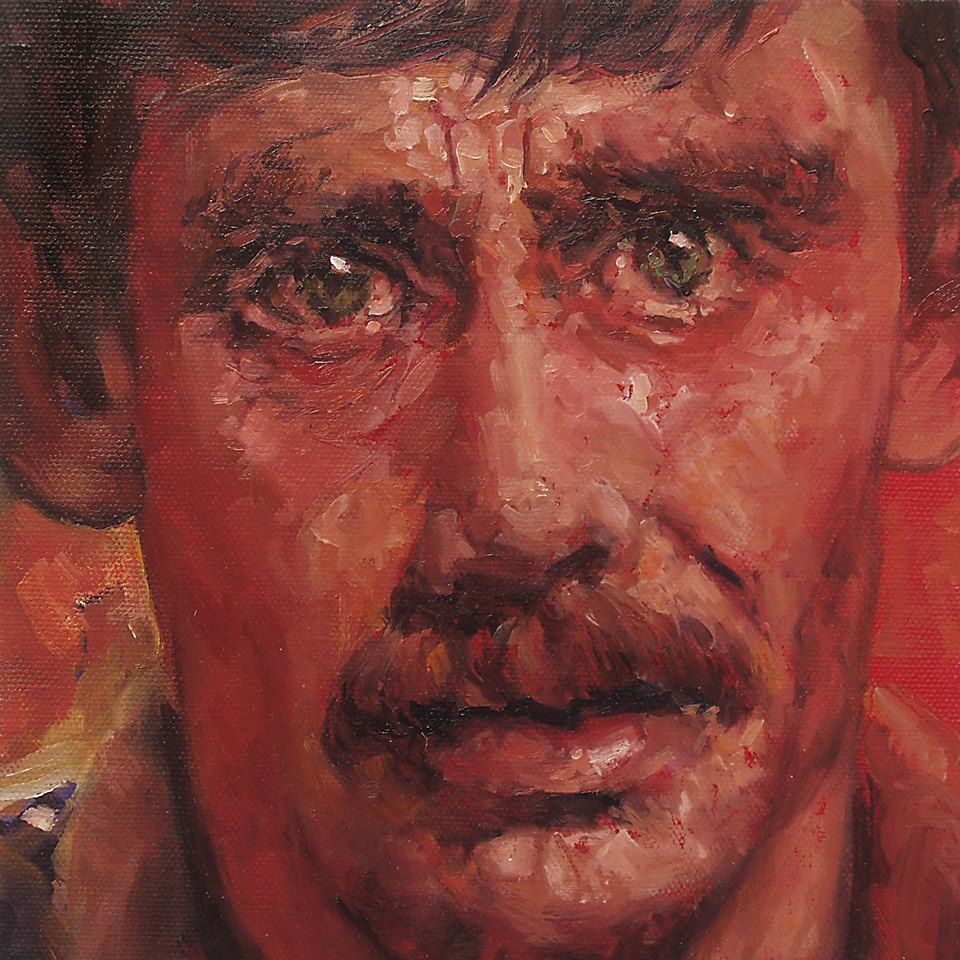Eoin Mac Lochlainn
'What I've seen no. 3'
A closer look by Lisa Brero, intern at Olivier Cornet Gallery
In early February 2023, Lisa Brero, intern at the Olivier Cornet Gallery wrote about Eoin Mac Lochlainn's 'What I've seen no. 3',
This painting on canvas (20x20cm) is still available (550 euro). It was part of our touring exhibition 'A Terrible Beauty', first shown at the VUE Art Fair in 2014, then in the Octagonal Room, City Assembly House, Dublin, in February-March 2015, by kind invitation of the Irish Georgian Society. The exhibition which was also shown here at the gallery, was an artists' response/reaction to the photographic work that François Bost carried out during the Battle of the Somme. Bost, Olivier Cornet's great grand uncle, served as a photographer in the French army during WW1.
"When I first saw this small and powerful painting which Eoin Mac Lochlainn masterfully produced, I was immediately captured by the look of terror in the wide eyes of this man, following you wherever you go [in the storage area of the gallery]. His ability to capture emotive expression is evident in Waiting, the larger of his two works currently on display as part of 2012-2022, a decade of art exhibitions at the Olivier Cornet Gallery, an anniversary group show that at the Olivier Cornet from December 2022 to February 2023.
The human experience of shock, pain, and disbelief clearly shines through this man’s face, his eyes glazed over and his lips ajar, the face of someone engaged in mental turmoil. After some research I discovered that it was one of the first paintings Eoin displayed with the Olivier Cornet Gallery, at the exhibition A Terrible Beauty, a touring group show that took place in three different locations between 2014 and 2015. The work forms part of a series of repetitions of the same portrait, named 'What I’ve seen', created by the artist from 2009 onwards. While each work is identical in dimension and subject matter, they are individualised through the use of light and colour. Some paintings are darker and defined, others lighter and more faded. It’s a process, an exploration of the emotional weight of the image. To quote the artist: “I was wondering how pale could I go. How far could I go before the poor guy finally disappeared…”
The brushstrokes on the canvas are thick and textured and catch the eye with their strong colours. The viewer is immediately connected to the mental obsession of this man, who had the horrors of the battle in front of him. The vivid red hue and the intense shades of brown make you feel among the damned in Dante’s hell. Just the green irises generate a spark of hope, giving us a glimpse of this person’s life before the war. They are the only part that remains unburnt, a safe corner of his soul where he finds shelter and starts to heal.
Eoin’s background as a graphic designer is evident in the composition of the image, the use of this narrow and cinematic frame highlights all the power of the sentiment. From a formal point of view, the 'What I’ve seen' series shows the difference between painting and photography or cinema as a means of representing reality. The original source of the image was indeed "Another Year", the ninth episode of the fourth season of the British period drama Upstairs, Downstairs. The actor Christopher Beeny plays the character of Edward, a foot soldier who later becomes a chauffeur, whose face was chosen for the painting. He goes to war and when he returns, though not physically wounded, he suffers badly from shell shock and is hospitalised.
'What I’ve seen no. 3', and the whole series to which it belongs, highlights the most significant themes at the core of Eoin's artistic practice: the focus on individuals and on their own stories, but also the social and political topics which can be seen reflected in this soldier, who becomes a symbol of human suffering. An abstract artist at the start of his career, Eoin has moved since then to figurative art to consider key political and social issues reported in the media: war, violence, homelessness, climate crisis. His aim as an artist is to go beyond the troubles of life and to give inspiration and strength to the viewer. Art can raise awareness, causing a shift in the audience’s perspective and thought, opening a breach in people’s consciousness. Hopefully, thanks to this powerful work we will all value peace once more."
Lisa Brero

